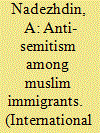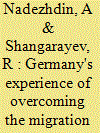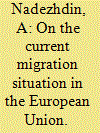| Srl | Item |
| 1 |
ID:
173271


|
|
|
|
|
| Summary/Abstract |
EXPERTS have for years been pointing to mounting xenophobic, anti-immigrant, and radical sentiments among the population of Europe. However, recently it is not only refugees and economic migrants from the Middle East and North Africa (MENA region) who have been facing hostility but also Jews who have lived in Europe permanently and have been integrated into European society. Usually, European anti-Semitism has been blamed on right-wing extremists and radicals, especially those in Hungary and Poland.1 There occur random instances of trivial anti-Semitic behavior, for example at school or in companies, that are not investigated or taken into account in police statistics.
|
|
|
|
|
|
|
|
|
|
|
|
|
|
|
|
| 2 |
ID:
169510


|
|
|
|
|
| Summary/Abstract |
AT A CDU/CSU PARTY CONGRESS in late 2015, German Chancellor Angela Merkel said her decision to allow all those who wished to cross the German border to do so freely was a "humanitarian imperative."1 On one hand, Germany is facing a labor shortage, which it planned to address by attracting foreigners. The plans of the German leadership to incorporate all the migrants who arrived in 2015-2016 into the national economy have not yet been fully implemented, and, conversely, the cost of supporting this group of individuals is an additional financial burden on the recipient society. It is obvious that illiterate young people who do not speak German and who wander city streets in groups and commit petty crimes are unlikely to become a driving force for modernizing industry and ensuring significant qualitative economic advancement.
|
|
|
|
|
|
|
|
|
|
|
|
|
|
|
|
| 3 |
ID:
180698


|
|
|
|
|
| Summary/Abstract |
THERE ARE CONCERNS in European countries about the possibility of recurrence of the 2015-2016 migration crisis in the near future. Doubts about the readiness of the European Union to resist a new wave of refugees from crisis regions and ensure protection of the bloc's external borders are confirmed by statistical data. At the end of 2019, Turkey, the EU's southern neighbor, experienced an increase in migration pressure when the total number of Syrian refugees in the country reached almost 3.7 million. The intensification of fighting in Idlib province in early 2020 contributed to the escalation of Erdogan's rhetoric; he has repeatedly called to stop deterring the increasing numbers of Syrian migrants from entering the European Union. As a result of the unilateral opening of the Turkish border with Greece at the end of February (it was closed on March 18 due to the threat of the spread of coronavirus), about 20,000 illegal migrants accumulated on the border. Many of them are not Syrian refugees fleeing the war but nationals of other states. For quite a lot of Afghans and Iraqis, Turkey is a transit country on their way to Europe. According to political analysts, Ankara's actions can be regarded as an instrument of pressure applied on Brussels in order to gain additional financial and political benefits over and above the EU-Turkey deal of 2016.
|
|
|
|
|
|
|
|
|
|
|
|
|
|
|
|